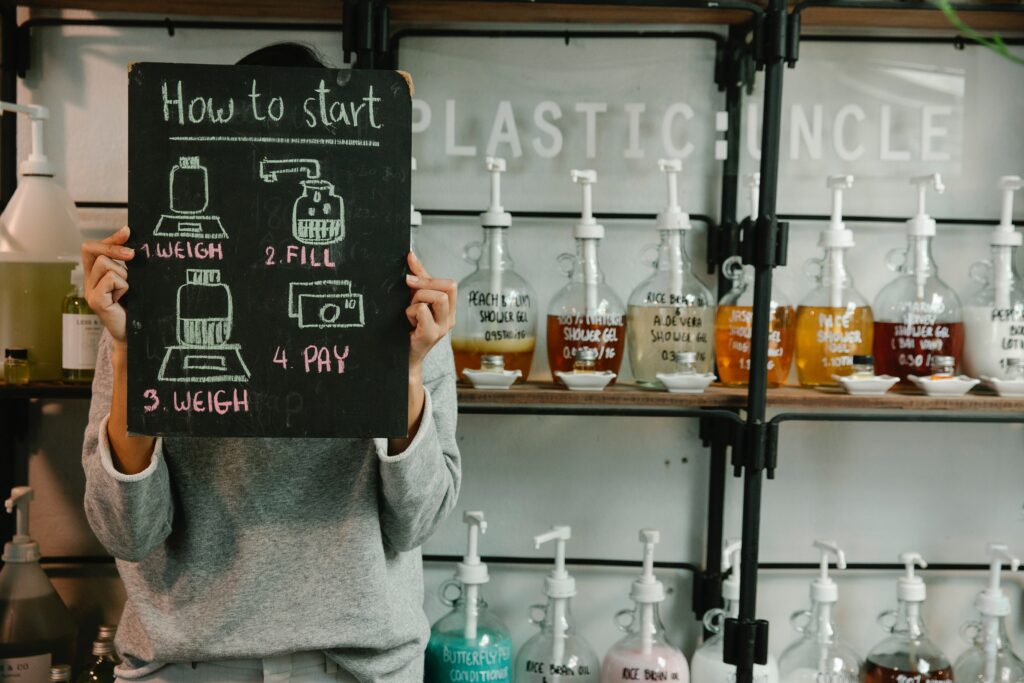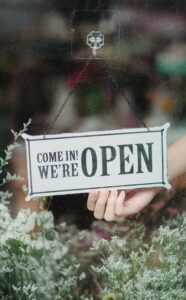In our fast-paced, consumption-driven society, convenience is king. And it comes heavily packaged. While vacuum-sealed avocados and the dreaded box-within-a-box-within-a-box may make great viral photographs, consumer waste is everywhere – and it’s a real problem.
We produce over 380 million tons of plastic every year, and less than 10% of it gets recycled. The rest makes a beeline to the dump (food packaging accounts for nearly a quarter of all landfill waste) or worse – it winds up in our ecosystems.
This creates a serious conundrum for eco-conscious small business-owners: what’s the alternative to all that waste?
Zero-Waste Stores – Unwrapped!
In recent years, more and more stores are centering their entire business models around being zero-waste. Also known as no-waste stores, plastic-free shops, and bulk refill stores, the goal is simple: eliminate all packaging and food waste. Generally, products come unwrapped and in bulk and customers are encouraged to bring their own bags and containers.
Why Open a Zero-Waste Store?
Customers increasingly prefer sustainable products, but three-quarters don’t feel comfortable identifying them on their own. When they’re confident they’re making a green choice, however, consumers are 78% more likely to head to checkout.
With sustainability at their core, zero-waste stores make it easy for consumers to avoid “what ifs” and excess impact. For eco-conscious entrepreneurs, it’s a win-win: going zero-waste is good for the planet – and for business.
But setting up shop is a big undertaking, especially when you’re bucking conventional systems. So, today, we’re unwrapping how to open a zero-waste store.
How to Open a Zero Waste Store or Bulk Goods Shop
1. Before You Open
Whether you want to open anew or zero-waste your current operations, it needs to be a smart business move. Before you commit, get to know your market, your competition, and your delivery logistics.
- Know Your Market: Are there enough potential customers to fill your aisles? (It’s not just rural vs. urban: a small eco-conscious community can be better than an unengaged metropolis.) Hit the streets and ask around – do people seem intrigued or interested?
- Know Your Competition: Understand your competitors to uncover opportunities in your community. What types of products are readily available (ex: fresh produce) and which are less abundant (ex: zero-waste home goods)? Seek to bring something new to your local landscape.
- Know Your Delivery Logistics: How you’ll stock your shelves will influence what you’ll stock. For instance, it may be easier to receive regular bulk and artisanal deliveries if you’re in a hub region; but rural shops may have easier access to farm-fresh goods and local produce.
2. Setting Up Shop
Popular Zero-Waste Products
If you want to open a zero-waste store, you need to stock products consumers want and need. Popular waste-free items include:
- reusable essentials like straws, food containers, and to-go cups;
- unwrapped/unpackaged produce, pantry items, and baking supplies;
- everyday essentials like bar soaps, shampoos, and laundry detergent;
- and paper-free swaps like cloth napkins, towels, and diapers.
Canvass your community to uncover what local consumers would like to see on your shelves. Consider creating a virtual survey with an in-store discount in exchange for feedback.
Zero-Waste & Packaging
- Pass on Packaging: Stock up on bulk bins, gravity dispensers, and large glass/stainless steel jars. This way, customers can portion out exactly what they need – and not a morsel more!
- Reusables Rule the Roost: Provide reusable cartons and bags for rent or purchase and encourage customers to BYO-Container.
- Opt for Whole Foods: Premixed and pre-packaged meals are convenient. They’re also often less healthy and create a lot of waste. Use your storefront to provide customers whole foods like rice, pastas, grains, and produce.
Stocking Produce & Perishables
- Don’t Overstock: Traditional supermarkets overstock so guests never have to leave empty handed. Unfortunately, this means around 30% of perishables expire before they’re sold – and wind up in the trash.
- Stock “Ugly” Produce: We toss around 20% of US produce because it’s misshapen, discolored, or just plain ugly. Join companies like Imperfect Foods and Misfits Market and give funny-looking food some love.
- Partner Up: Pass along surplus/expiring goods to like-minded local groups and businesses. Need some inspiration? NYC Compost Project creates nutrient rich fertilizer from food waste, while City Harvest and NY Common Pantry connect food-insecure households with surplus staples.
Leveraging Technology
- Virtual Receipts: Believe it or not, paper receipts generate over 300 million pounds of waste annually in the US alone. E-receipt apps like e.pop provide virtual proof of purchase that’s easy, secure, and sustainable!
- QR Codes/Digital Signage: Rotating selections and daily specials can mean lots of trips to the printer. Virtual QR codes and digital signage connect customers with the info they need, without the paper waste.
- Social Media: By using social media to let your audience know which perishable items you’ve got in surplus, we can all work together to reduce food waste.
- Dig Into Digital: Read our guide How to Take Advantage of the Digital Transformation in Retail and try out a few handy new tools.
Conserving Resources
If you’re learning how to open a zero waste store, you’re probably focused on eliminating plastic, packaging, and food waste. But there’s another sneaky culprit: resource waste. Take steps to conserve water, electricity, and energy-use in your storefront to improve sustainability from every angle. Explore e.pop’s Ultimate Guide to Sustainable Retail for helpful ideas to get you started.
3. Getting the Word Out
 Build a Loyal Local Following
Build a Loyal Local Following
Here’s some good news: 68% of consumers say they’re more loyal to brands that share their values. But this only matters if they know you exist! Make a splash in your community by putting in the extra effort to connect. You might:
- offer opening day specials and promotions;
- host in-store events centered around zero-waste living;
- attend local sustainability events to find “your people;”
- team up with like-minded businesses to maximize your reach and impact.
Master Digital Marketing
The best part of opening a zero waste store is that many impactful marketing efforts are now completely digital – i.e., they’re waste-free! Consider:
- running local Google and social media ads;
- starting a zero-waste blog (don’t forget about SEO!);
- building your social presence by partnering with eco-influencers;
- offsetting your virtual emissions though a green web host.
Leverage Digital Receipt Advertising
Forget about foot-long paper receipts; try out dynamic, personalized promotions instead. With e-receipt apps like e.pop, merchants can create virtual offers tailored to their customers’ demographics and shopping habits. The best part? They’re stored in a central application and impossible to misplace or damage.
Learn more about Boosting Business with Digital Receipt Advertising
4. Get (and Stay!) Inspired
Take Notes from the Pros
No zero-waste store is an island. Join virtual and IRL groups for waste-free business owners to learn and get inspired. Follow other zero-waste entrepreneurs on social media to learn how they talk about their vision. And explore this State-by-State Zero Waste Grocery Guide to take notes on what the pros are up to.
Progress Over Perfection
Going zero waste is CHALLENGING. Don’t let perfection be the enemy of progress. Do what you can and seek ways to improve and innovate along the way. Remember: every step towards a sustainable future matters.
It’s Time to #RedoReceipts
e.pop’s innovative digital receipt solution helps merchants connect with consumers, grow their business, and showcase their pledge to sustainability. Sign up today to increase your sales and reach more customers – and get your first year free!
Join the Fight Against Climate Change
and much more. Get retail tips, trends and news! Be part of the e.pop merchant community!

Marley Flueger
Freelance sustainability writer working to demystify the climate crisis, connect people with tools for lighter living, and create pathways for us all to push the needle towards a fossil fuel-free and equitable future.



I’m very pleased to learn such brilliant piece of article. I appreciate your hard work. Thank you for sharing. I will also share some useful information.